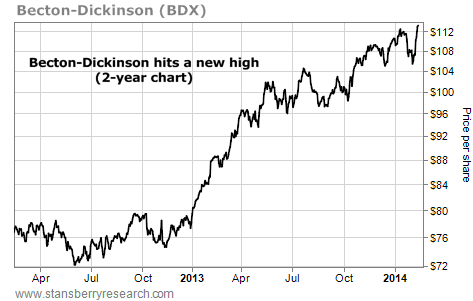| Home | About Us | Resources | Archive | Free Reports | Market Window |
Oh Yeah? So What's YOUR Exit Strategy?By
Friday, February 14, 2014
My friend Mark LoPresti caught me...
I had my chest out, proudly telling him a stock story. "I bought the stock around $2. It ran from about $2 to $8.75. And it's now around $6.50 today," I explained.
Mark listened politely. Then he asked exactly the right question: "So what's your exit strategy?"
The correct answer, to my own dismay, was that I didn't have a proper one... He got me.
I have some ideas in my head about how this will end... The stock could be taken over for around $15 a share. Liquidation value is probably (worst-case) around $8 a share.
But neither of those is an actual exit strategy... They are simply benchmarks in my head.
A good trade consists of two things... a good entry price and a good exit price. I got the first part right... But it seems I don't have a clear plan for the second part. And that's no good!
Meanwhile, the stock is now down about 25% from its highs...
The typical exit strategy I recommend in my newsletters is a 25% "trailing stop." Based on my own advice, I should sell this stock now, right?
Typically, if I use a 25% trailing stop, I expect the idea has the potential for at least a 75% return. That way, my "reward-to-risk ratio" is 3 to 1.
I think of investing in this way: What's my potential reward? And how can I control my risk?
There are plenty of exit strategies out there (beyond your basic trailing stops). And there are many variations on those strategies (like volatility-based stops, dollar-based stops, and much more).
Nobody cares more about teaching you how to get exit strategies right than my good friend Dr. Richard Smith. I highly recommend you visit his website and check out his plans there to learn more about them. (I don't get any compensation for mentioning Richard's site, but TradeStops is our corporate affiliate.)
My goal today isn't to go over all your choices in exit strategies. It's to teach you that you must always have an exit strategy in place when you enter a position.
What will make you sell? How much does it have to go down, or up, to cause you to sell? If you can't answer those questions, you have no exit strategy. With no exit strategy, you are officially "winging it."
I thought I would never be caught without an exit strategy...
But my friend Mark caught me.
I have my excuses... As I told Mark, "The stock is extremely illiquid, so I can't use a traditional trailing stop."
That is true.
However, that misses the point... I might not be able to use a traditional trailing stop... but still, at this point, I don't have a defined sell strategy if things go wrong. I'll have to work on the exit strategy for my trade...
I recommend you head over to www.TradeStops.com and start creating exit strategies for your stocks if you don't already have them in place...
Please, don't get bogged down... The important thing is to have a plan. Just about any plan is better than no plan at all... So get your exit strategies together now...
Good investing,
Steve
Further Reading:
If you never know what to do when a trade turns against you, Amber Lee Mason says the solution is easy. "It'll take you about three minutes, a scrap of paper, and a pen. And you'll never have this problem again." Learn three things you MUST do before you make your next trade.
Along with having an exit strategy, S&A Editor in Chief Brian Hunt says there's something "everyone with money in the market should do at least once a year." Learn what this simple exercise is... and how it can drastically improve your trading performance in this brief interview.
Market NotesA PICTURE OF THE MEDICAL-STOCK BULL MARKET It's a bull market in medical services... just ask shareholders of Becton-Dickinson (BDX).
Regular DailyWealth readers are familiar with Dr. David Eifrig's extremely profitable stance on health care stocks. For years, "Doc" has highlighted the opportunities here. The giant Baby Boom generation is entering its prime medical-service-consumption era. Obamacare will create huge demand for all kinds of medical services and devices.
For an example of this idea at work, we present the past two years' trading in Becton-Dickinson. Becton-Dickinson is the world's largest maker of syringes and needles. It's also a huge player in diagnostic services. The business has been around for more than 100 years. It has increased its dividend payment every year for more than 30 years. It's a blue chip in the medical-stock sector.
As you can see, being a blue-chip medical company is a good thing these days. Becton-Dickinson shares have climbed from $75 to $113 in the past 18 months... and just struck a new all-time high. It's boom times for the medical industry.
 |
In The Daily Crux
Recent Articles
|


